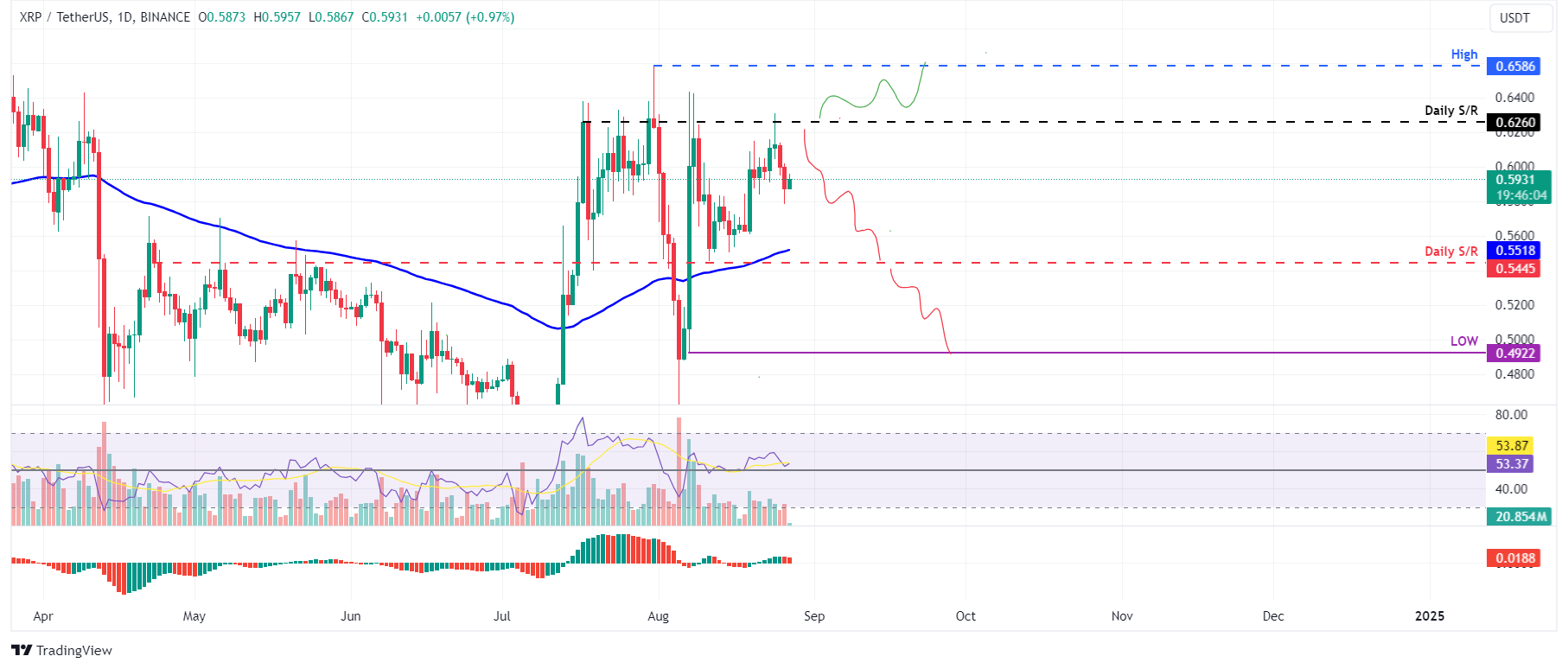Ripple price is poised for a decline as on-chain metrics show a negative trend
- Ripple price retests and fails to overcome the daily resistance level at $0.626, leaning towards a price decline ahead.
- On-chain data paints a bearish picture for XRP, with negative OI-Weighted Funding Rate and long-to-short ratio below one.
- A daily candlestick close above $0.626 would invalidate the bearish thesis.
Ripple's (XRP) price looks set to unwind most of its recent gains after it retested and failed to overcome resistance from the daily resistance level on Saturday and declined 4.23% in the next two days. At the time of writing, it trades slightly up 1% on Tuesday. Additionally, the suggestion of on-chain data supports the bearish trend ahead, as evidenced by the negative OI-Weighted Funding Rate and a long-to-short ratio below one.
Ripple price set for a decline after retesting its daily resistance barrier
Ripple price retested and was rejected by its daily resistance level at $0.626 on Saturday. It declined 4.23% in the next two days. On Tuesday, it trades slightly up by 1% to $0.593.
If the Ripple price continues to retrace, it could decline 8% from its current trading level at $0.593 to retest its daily support at $0.544.
The Relative Strength Index (RSI) and the Awesome Oscillator (AO) indicators on the daily chart trade just above their neutral levels of 50 and zero, respectively. Both indicators must trade below their neutral levels for the bearish momentum to be sustained.

XRP/USDT daily chart
Coinglass's OI-Weighted Funding Rate data is a crucial metric for traders and analysts to assess market sentiment and predict future price movements. This metric relies on funding rates from futures contracts, weighted by their open interest. A positive rate (Longs pay shorts) typically signals bullish sentiment, as long positions compensate shorts. Conversely, a negative rate (Shorts pay Longs) indicates bearish sentiment, with shorts compensating longs.
In the case of XRP, this metric stands at -0.0084%, reflecting a negative rate, indicating that shorts are paying longs. This scenario often signifies bearish sentiment in the market, suggesting potential downward pressure on Ripple's price.

XRP OI-Weighted Funding Rate chart
Additionally, Coinglass's data shows that XRP's long-to-short ratio is 52.43%. This ratio reflects bearish sentiment in the market, as the number has a higher percentage of shorts compared to longs, suggesting that more trades anticipate the price of the asset to decline, bolstering Ripple's bearish outlook.

XRP long-to-short ratio
However, if the Ripple price closes above the $0.626 daily resistance level, it would shift the market structure by creating a higher high on the daily chart, potentially leading to a 5.3% rise to revisit the July 31 high of $0.658.
Cryptocurrency metrics FAQs
The developer or creator of each cryptocurrency decides on the total number of tokens that can be minted or issued. Only a certain number of these assets can be minted by mining, staking or other mechanisms. This is defined by the algorithm of the underlying blockchain technology. Since its inception, a total of 19,445,656 BTCs have been mined, which is the circulating supply of Bitcoin. On the other hand, circulating supply can also be decreased via actions such as burning tokens, or mistakenly sending assets to addresses of other incompatible blockchains.
Market capitalization is the result of multiplying the circulating supply of a certain asset by the asset’s current market value. For Bitcoin, the market capitalization at the beginning of August 2023 is above $570 billion, which is the result of the more than 19 million BTC in circulation multiplied by the Bitcoin price around $29,600.
Trading volume refers to the total number of tokens for a specific asset that has been transacted or exchanged between buyers and sellers within set trading hours, for example, 24 hours. It is used to gauge market sentiment, this metric combines all volumes on centralized exchanges and decentralized exchanges. Increasing trading volume often denotes the demand for a certain asset as more people are buying and selling the cryptocurrency.
Funding rates are a concept designed to encourage traders to take positions and ensure perpetual contract prices match spot markets. It defines a mechanism by exchanges to ensure that future prices and index prices periodic payments regularly converge. When the funding rate is positive, the price of the perpetual contract is higher than the mark price. This means traders who are bullish and have opened long positions pay traders who are in short positions. On the other hand, a negative funding rate means perpetual prices are below the mark price, and hence traders with short positions pay traders who have opened long positions.

